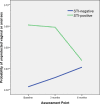The impact of community-based sexually transmitted infection screening results on sexual risk behaviors of African American adolescents
- PMID: 20547287
- PMCID: PMC2917098
- DOI: 10.1016/j.jadohealth.2009.12.024
The impact of community-based sexually transmitted infection screening results on sexual risk behaviors of African American adolescents
Abstract
Purpose: To examine the effect of a community-based sexually transmitted infection (STI) screening program on sexual risk behavior among African American adolescents. We hypothesized that adolescents testing positive for an STI and receiving post-test counseling would reduce risky sexual practices, whereas STI-negative adolescents would show little or no change in protective sexual behavior after screening.
Methods: From August 2006 to January 2008, we recruited 636 sexually active African American adolescents (age, 14-17) from community-based organizations in two mid-sized U.S. cities with high STI prevalence. Participants were screened for three STIs (gonorrhea, chlamydia, and trichomoniasis) and completed an audio computer-assisted self-interview. Youth who tested positive for an STI (6.6%) received treatment and counseling. Youth testing negative received no further intervention. Approximately 85% of participants completed 3- and 6-month follow-up assessments. Generalized estimating equations determined the effects of STI screening on adolescents' number of sexual partners and occurrence of unprotected sex.
Results: Adolescents who tested positive for an STI reduced their number of vaginal and oral sex partners and the probability of unprotected sex. STI-negative adolescents demonstrated no change for numbers of partners or unprotected sex.
Conclusions: Community-based STI screening can help to reduce sexual risk behavior in youth who test positive for STIs. Alternative approaches will be needed to reduce risk behavior in youth who test negative but who are nevertheless at risk for acquiring an STI.
Copyright (c) 2010 Society for Adolescent Health and Medicine. Published by Elsevier Inc. All rights reserved.
Figures
Similar articles
-
Long term effects of community-based STI screening and mass media HIV prevention messages on sexual risk behaviors of African American adolescents.AIDS Behav. 2011 Nov;15(8):1755-63. doi: 10.1007/s10461-011-9946-6. AIDS Behav. 2011. PMID: 21484280 Free PMC article.
-
Alcohol use as a marker for risky sexual behaviors and biologically confirmed sexually transmitted infections among young adult African-American women.Womens Health Issues. 2011 Mar-Apr;21(2):130-5. doi: 10.1016/j.whi.2010.10.005. Epub 2011 Jan 28. Womens Health Issues. 2011. PMID: 21276736 Free PMC article.
-
Efficacy of an HIV/STI sexual risk-reduction intervention for African American adolescent girls in juvenile detention centers: a randomized controlled trial.Women Health. 2014;54(8):726-49. doi: 10.1080/03630242.2014.932893. Women Health. 2014. PMID: 25190056 Free PMC article. Clinical Trial.
-
Factors related to sexual practices and successful sexually transmitted infection/HIV intervention programs for Latino adolescents.Public Health Nurs. 2013 Sep-Oct;30(5):390-401. doi: 10.1111/phn.12039. Epub 2013 Apr 29. Public Health Nurs. 2013. PMID: 24000911 Review.
-
Factors related to risky sexual behaviors and effective STI/HIV and pregnancy intervention programs for African American adolescents.Public Health Nurs. 2014 Sep-Oct;31(5):414-27. doi: 10.1111/phn.12128. Epub 2014 May 22. Public Health Nurs. 2014. PMID: 24850214 Review.
Cited by
-
Repeat testing for chlamydia trachomatis, a "safe approach" to unsafe sex? a qualitative exploration among youth in Stockholm.BMC Health Serv Res. 2017 Nov 15;17(1):730. doi: 10.1186/s12913-017-2681-6. BMC Health Serv Res. 2017. PMID: 29141635 Free PMC article.
-
Safer sex media messages and adolescent sexual behavior: 3-year follow-up results from project iMPPACS.Am J Public Health. 2013 Jan;103(1):134-40. doi: 10.2105/AJPH.2012.300856. Epub 2012 Nov 15. Am J Public Health. 2013. PMID: 23153149 Free PMC article. Clinical Trial.
-
Incidence and persistence of carcinogenic genital human papillomavirus infections in young women with or without Chlamydia trachomatis co-infection.Cancer Med. 2015 Oct;4(10):1589-98. doi: 10.1002/cam4.496. Epub 2015 Jul 21. Cancer Med. 2015. PMID: 26194784 Free PMC article.
-
A human immunodeficiency virus posttest video to increase condom use among adolescent emergency department patients.J Adolesc Health. 2013 Jul;53(1):79-84. doi: 10.1016/j.jadohealth.2013.01.028. Epub 2013 Apr 9. J Adolesc Health. 2013. PMID: 23582525 Free PMC article. Clinical Trial.
-
Long term effects of community-based STI screening and mass media HIV prevention messages on sexual risk behaviors of African American adolescents.AIDS Behav. 2011 Nov;15(8):1755-63. doi: 10.1007/s10461-011-9946-6. AIDS Behav. 2011. PMID: 21484280 Free PMC article.
References
-
- CDC . Trends in reportable sexually transmitted diseases in the United States, 2006. Centers for Disease Control and Prevention; Atlanta: 2006. [accessed 1st Sept. 2009]. http://www.cdc.gov/std/stats/trends2006.htm.
-
- CDC . Consultation to address STD disparities in African American communities. CDC; Atlanta: 2007. [accessed 1st Sept. 2009]. http://www.cdc.gov/std/general/STDHealthDisparitiesConsultationJune2007.pdf.
-
- Hook EW, 3rd, Handsfield HH. Gonoccal infections in the adult. In: Holmes KK, Mardh P, Sparling PF, editors. Sexually Transmitted Diseases. Vol. 2008. McGraw-Hill; New York: NY: pp. 627–646.
Publication types
MeSH terms
Grants and funding
LinkOut - more resources
Full Text Sources
Medical



